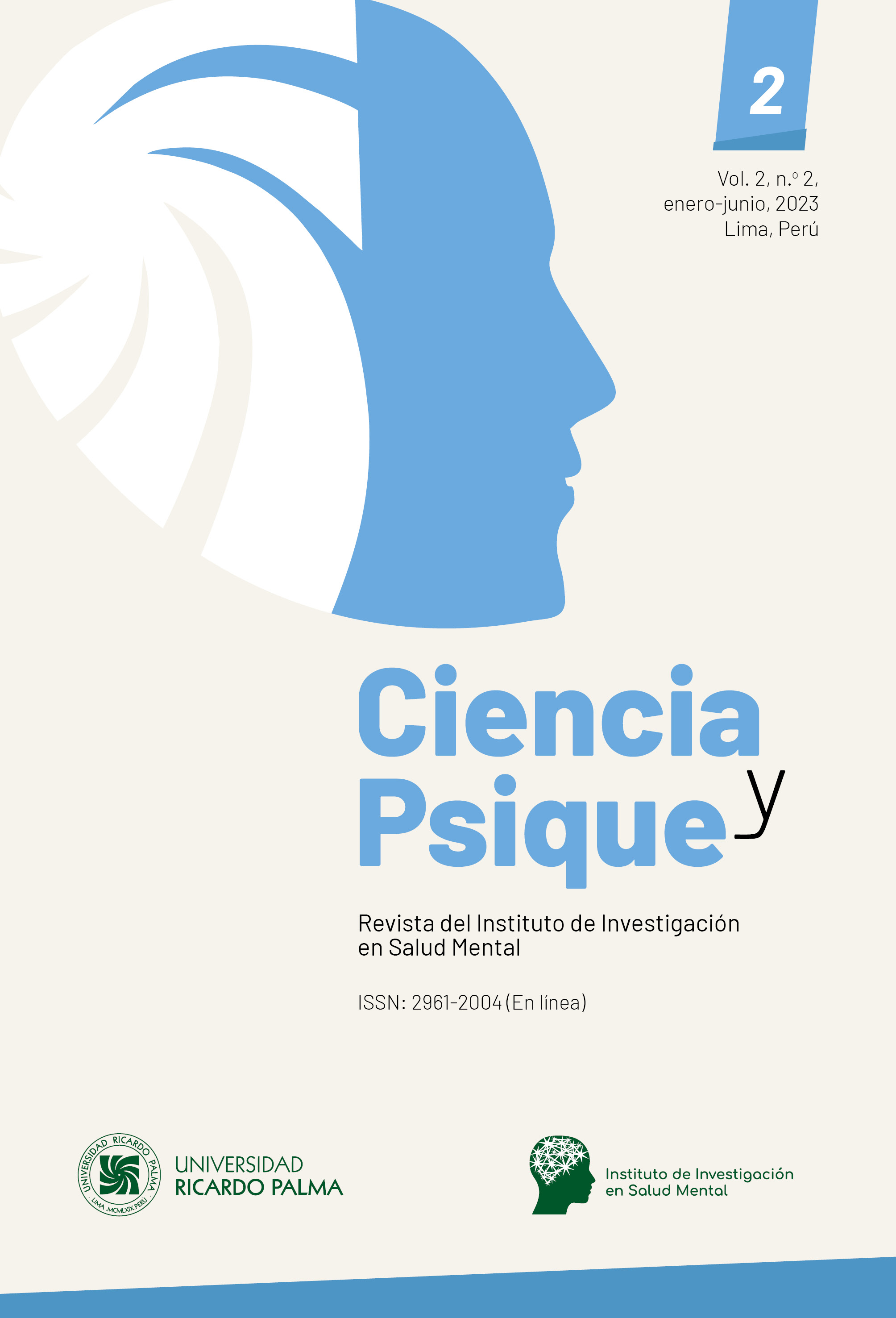La capacidad empática en estudiantes universitarios durante la pandemia: un estudio exploratorio
DOI:
https://doi.org/10.59885/cienciaypsique.2023.v2n2.04Palabras clave:
universitarios, empatía cognitiva, empatía afectiva, pandemiaResumen
Es de gran importancia analizar el concepto de la empatía, debido a que se considera un constructo sustancial para comprender diversos aspectos del comportamiento humano. Nuestro objeto principal es investigar la capacidad empática y comparar los niveles de empatía afectiva y cognitiva en 63 jóvenes, cuya edad promedio es de 17.8 años, de ambos sexos, que ingresaron a la universidad y se encontraban en la etapa adolescente durante la pandemia de la COVID-19. Se utilizó la prueba de empatía desarrollada por Jolliffe y Farrington (2006). Este estudio se enmarca en un diseño descriptivo transversal con una muestra previamente seleccionada en su entorno natural. Se empleó el software estadístico SPSS, utilizando estadísticas descriptivas básicas, así como el análisis de la distribución normal según la prueba de Kolmogorov-Smirnov y la prueba no paramétrica U de Mann-Whitney para las comparaciones. Los resultados revelaron que los participantes obtuvieron un nivel promedio o normal en relación con la empatía total, quedando en el centil 50. De modo concluyente, se observaron diferencias significativas entre los niveles de empatía afectiva (40) y empatía cognitiva (60). Se evidenció una disparidad notable en los niveles de empatía afectiva, donde los varones (60) obtuvieron puntajes considerablemente más altos que las mujeres (35), lo cual reveló que en los varones universitarios prevalece una elevada capacidad de empatía y tienden a percibir y experimentar buena calidad y receptividad humana.
Citas
Casimiro, J. F., Benites, J. C., Sánchez, F. M., Flores, V. R., & Palma, F. (2020). Percepción de la conducta por aislamiento social obligatorio en jóvenes universitarios por COVID-19. Revista Conrado, 16(77), 74-80. https://conrado.ucf.edu.cu/index.php/conrado/ar ticle/view/1569
Conde, E. (2015). Empatía y conducta antisocial en adolescentes. Convergencia de dos medidas de empatía y su relación con la conducta antisocial [Tesis doctoral, Universidad de Castilla-La Mancha].
Cossío, A. (2023). Condiciones socioemocionales en la etapa infantil: horizontes conceptuales. Editorial de la Universidad Ricardo Palma.
Cuff, B. M., Brown, S. J., Taylor, L. K., & Howat, D. (2016). Empathy: A review of the concept. Emotion Review, 8(2), 144-153. https://doi.org/10.1177/1754073914558466
Davis, M. H. (1983). Measuring individual differences in empathy: Evidence for a multidimensional approach. Journal of Personality and Social Psychology, 44(1), 113-126. https://doi.org/10.1037/0022-3514.44.1.113
Decety, J., & Cowell, J. M. (2014). The complex relation between morality and empathy. Trends in Cognitive Sciences, 18(7), 337-339. https://doi.org/10.1016/j.tics.2014.04.008
Decety, J., & Jackson, P. L. (2004). The functional architecture of human empathy. Behavioral and Cognitive Neuroscience Reviews, 3(2), 71- 100. https://doi.org/10.1177/1534582304267187
Decety, J., & Lamm, C. (2009). Empathy versus Personal Distress: Recent evidence from social neuroscience. En J. Decety & W. Ickes (Eds.), The social neuroscience of empathy (pp. 199-214). The MIT Press. https://doi.org/10.7551/mitpress/9780262012973.003.0016
Eisenberg, N. (2000). Emotion, regulation, and moral development. Annual Review of Psychology, 51(1), 665-697. https://doi.org/10.1146/annurev.psych.51.1.665
Eisenberg, N., Carlo, G., Murphy, B., & Van Court, P. (1995). Prosocial development in late adolescence: A longitudinal study. Child Development, 66(4), 1179-1197. https://doi.org/10.2307/1131806
Eisenberg, N., & Eggum, N. D. (2009). Empathic responding: Sympathy and personal distress. En J. Decety & W. Ickes (Eds.), The social neuroscience of empathy (pp. 71-83). The MIT Press. https://doi.org/10.7551/mitpress/9780262012973.003.0007
Fernández-Pinto, I., López-Pérez, B., & Márquez, M. (2008). Empatía: Medidas, teorías y aplicaciones en revisión. Anales de Psicología, 24(2), 284-298. https://revistas.um.es/analesps/article/view/42831
Fernández, A. V., & Zahavi, D. (2020). Basic empathy: Developing the concept of empathy from the ground up. International Journal of Nursing Studies, 110, 103695. https://doi.org/10.1016/j.ijnurstu.2020.103695
Garaigordobil, M., & García, P. (2006). Empatía en niños de 10 a 12 años. Psicothema, 18(2), 180-186. https://www.psicothema.com/pdf/3195.pdf
Jolliffe, D., & Farrington, D. P. (2006). Development and validation of the Basic Empathy Scale. Journal of Adolescence, 29(4), 589-611. https://doi.org/10.1016/j.adolescence.2005.08.010
Kelm, Z., Womer, J., Walter, J. K., & Feudtner, C. (2014). Interventions to cultivate physician empathy: A systematic review. BMC Medical Education, 14(219). https://doi.org/10.1186/1472-6920-14-219
Hoffman, M. L. (1977). Sex differences in empathy and related behaviors. Psychological Bulletin, 84(4), 712-722. https://doi.org/10.1037/0033-2909.84.4.712
Hu, Y., Ye, B., & Im, H. (2021). Hope and post-stress growth during COVID-19 pandemic: The mediating role of perceived stress and the moderating role of empathy. Personality and Individual Differences, 178, 110831. https://doi.org/10.1016/j.paid.2021.110831
León, X. P. (2022). La empatía en la educación virtual: una propuesta de aprendizaje significativo. Mentor. Revista de Investigación Educativa y Deportiva, 1(1), 55-65. https://doi.org/10.56200/mried.v1i1.2167
Lovón, M. A., & Cisneros, S. A. (2020). Repercusiones de las clases virtuales en los estudiantes universitarios en el contexto de la cuarentena por COVID-19: el caso de la PUCP. Propósitos y Representaciones, 8(SPE3), e588. https://doi.org/10.20511/pyr2020.v8nspe3.588
Martínez, E. (2022). Empatía y acoso escolar en estudiantes de secundaria de una institución educativa del Callao, 2022 [Tesis de maestría, Universidad César Vallejo]. https://repositorio.ucv.edu.pe/handle/20.500.12692/106308
Navarro, S., Maluenda, J., & Varas, M. (2016). Diferencias en empatía según sexo y área disciplinar en estudiantes universitarios chilenos de la provincia de Concepción, Chile. Educación, 25(49), 63-82. https://doi.org/10.18800/educacion.201602.004
Rodríguez, L., & Moreno, J. (2016). Posturas éticas y empatía, predictores de prosocialidad y de penalización de faltas y delitos. Acción Psicológica, 13(2), 43-56. https://doi.org/10.5944/ap.13.2.17809
Sánchez-Queija, I., Oliva, A., & Parra, Á. (2006). Empatía y conducta prosocial durante la adolescencia. Revista de Psicología Social, 21(3), 259-271. https://doi.org/10.1174/021347406778538230
Sánchez, H., & Reyes, C. (2015). Metodología y diseños en la investigación científica. Business Support Aneth.
Usán, P., Salavera, C., Quílez, A., Lozano, R., & Latorre, C. (2023). Empathy, self-esteem and satisfaction with life in adolescent. Children and Youth Services Review, 144, 106755. https://doi.org/10.1016/j.childyouth.2022.106755
VanCleave, D. S. (2016). Contributions of neuroscience to a new empathy epistemology: Implications for developmental training. Advances in Social Work, 17(2), 369-389. https://doi.org/10.18060/21087
World Health Organization. (2020). Mental health and psychosocial considerations during the COVID-19 outbreak. https://www.who.int/publications/i/item/WHO-2019-nCoV-MentalHealth-2020.1
Zorza, J. P., Marino, J., De Lemus, S., & Acosta, A. (2013). Academic performance and social competence of adolescents: Predictions based on effortful control and empathy. Spanish Journal of Psychology, 16, E87. https://doi.org/10.1017/sjp.2013.87
Descargas
Publicado
Cómo citar
Número
Sección
Licencia
Derechos de autor 2023 Ciencia y Psique

Esta obra está bajo una licencia internacional Creative Commons Atribución 4.0.




